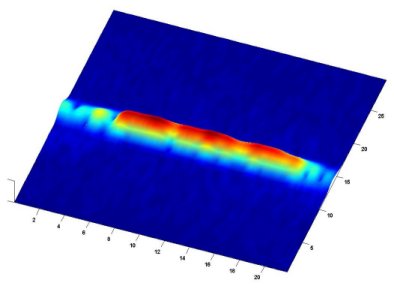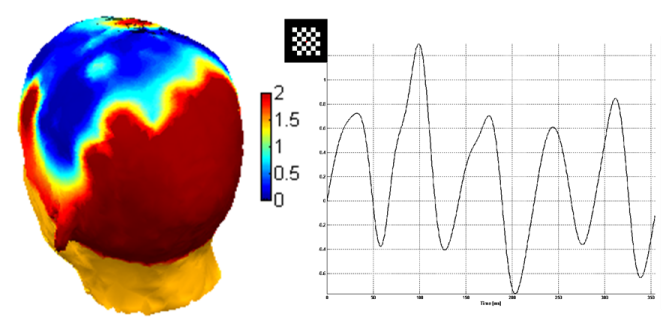| Steady-State Visual Evoked Potentials (SSVEP) are EEG brain responses that are precisely synchronized with fast (e.g. more than 4Hz) repetitive external visual stimulation such as flashes, reversing patterns or luminance-modulated images. SSVEP responses can be measured within narrow frequency bands (such as ±0.1 Hz) around the visual stimulation frequency, or using other signal processing methods that exploit the specific characteristics of the SSVEP signal, such as rhythmicity and synchronization. The strongest responses occur in the primary visual (striate) cortex, although other brain areas are also activated in varying degrees. |
| SSVEP Stimuli(single
checkeboards for brain response
evaluation)
(see details in readme.txt file)
|
SSVEP-BCI
Stimuli (for 8-channel BCI [Brain-Computer
Interface])
|
| SSVEP DATA (see readme.txt file) | |||
| IMPORTANT NOTICES: 1. This research EEG database is released to the public with the hope that it can stimulate progress in neuroscience, signal processing and other fields of research. 1. Copyright holders for this database are Dr. Hovagim Bakardjian and RIKEN-LABSP 2. By using this data for any scientific publication, you agree to include a reference to the following original work: Bakardjian H, Tanaka T, Cichocki A, Optimization of SSVEP brain responses with application to eight-command Brain–Computer Interface, Neurosci Lett, 2010, 469(1):34-38. (http://dx.doi.org/10.1016/j.neulet.2009.11.039) 3. If any part of this data is used for commercial applications, explicit permission must be obtained from the copyright holders. Note also the following patent: Bakardjian, H., Martinez, P., Cichocki, A., Robust Multi-Command SSVEP-Based Brain-Machine Interface Without Training using Small Moving or Stationary Patterns, Japanese Patent #22385, 2008 4. Access to this EEG database has been made available without registration and limitations but, please, send an acknowledgement email to Dr. Hovagim Bakardjian, and make sure to include a reference in your work (as noted above), in order to acknowledge the efforts and time invested by the creator(s). 5. Please, note that although this copyrighted work has been made available, no support can be provided. Thank you for your understanding and cooperation. |
PLEASE, INCLUDE THE FOLLOWING REFERENCE IF USING THIS COPYRIGHTED SSVEP DATABASE: Bakardjian
H, Tanaka T, Cichocki A, Optimization of SSVEP brain responses with
application to eight-command Brain–Computer Interface, Neurosci Lett,
2010, 469(1):34-38.
PLEASE, SEND ACKNOWLEDGEMENT EMAIL TO Dr. Hovagim Bakardjian (IF YOU DOWNLOAD)
References
Bakardjian H, Tanaka T, Cichocki A, Optimization of SSVEP brain responses with application to eight-command Brain–Computer Interface, Neurosci Lett, 2010, 469(1):34-38. http://dx.doi.org/10.1016/j.neulet.2009.11.039
Bakardjian H, Tanaka T, Cichocki A, Emotional faces boost up steady-state visual responses for brain-computer interface, NeuroReport 2011, 22(3):121-125. http://dx.doi.org/10.1097/WNR.0b013e32834308b0




